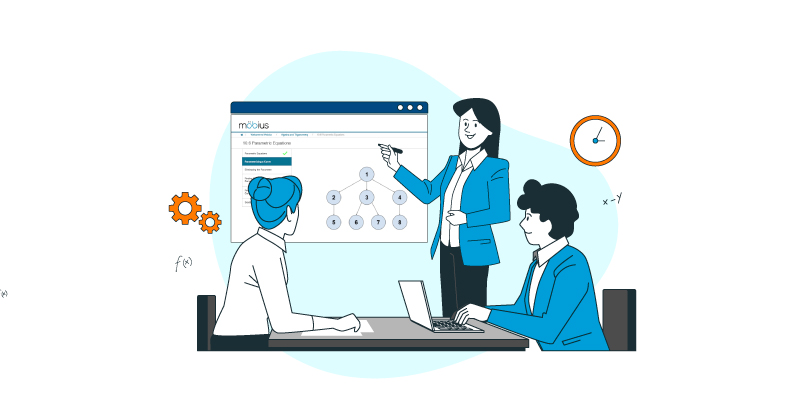HyFlex Learning: Transforming STEM Education for 21st Century

As the landscape of education evolves, innovative teaching models emerge to meet the diverse needs of students and educators. One such model gaining traction is HyFlex learning. This blog will delve into the HyFlex learning model, its significance, benefits, and limitations, and how platforms like Möbius can help implement it effectively in STEM education.
What is HyFlex Learning?
The HyFlex (Hybrid Learning + Flexible Learning) learning model, introduced by Dr. Brian Beatty at San Francisco State University in 2006, merges face-to-face and online instruction, offering students unparalleled flexibility. They can choose to attend classes in person, participate online, or engage in a mix of both. This model incorporates three core components:
- Hybrid Learning: Courses are designed to support both in-person and online learners simultaneously, ensuring a consistent, high-quality experience.
- Flexible Learning: Students select their preferred mode of attendance, tailoring their learning experience to individual needs and schedule.
- Synchronous and Asynchronous Activities: HyFlex courses feature blended learning to accomodate real-time and self-paced learning, fostering engagement and collaboration.
Unlike traditional learning models that confine students to a single mode of instruction, HyFlex allows seamless transitions between different environments, accommodating diverse learning preferences.
Why Embrace HyFlex Learning in STEM Education?
HyFlex model offers several advantages that make it particularly suited for STEM education.
Increased Accessibility
- Accommodating Diverse Learners: HyFlex learning caters to students with varying schedules, learning preferences, and responsibilities, making education more accessible.
- Reducing Barriers for Students with Disabilities: Multiple modes of instruction and engagement can better serve students with physical, cognitive, or sensory limitations, fostering a more inclusive educational environment.
Enhanced Student Engagement and Motivation
- Student Choice and Preference: Allowing students to choose their learning mode increases motivation, engagement, and overall satisfaction.
- Opportunities for Collaboration and Interaction: The integration of synchronous and asynchronous activities encourages interaction among students and instructors, building a sense of community.
Improved Learning Outcomes
- Personalized Digital Learning: HyFlex learning enables students to tailor their educational experience, leading to better understanding and retention of course material.
- Formative Assessment and Feedback: Diverse learning activities provide numerous opportunities for instructors to assess progress and offer individualized feedback.
Increased Instructor Efficiency and Flexibility
- Streamlined Course Design: Designing a HyFlex course involves careful planning, resulting in efficient course structures and adaptable materials.
- Opportunities for Innovative Teaching Methods: The HyFlex model encourages instructors to explore new pedagogical approaches and technologies, enhancing their teaching practice.
Sustainability and Adaptability
- Resilience During Uncertain Times: HyFlex learning enables institutions to adapt quickly to changing circumstances, such as public health emergencies, ensuring educational continuity.
- Scalability and Resource Optimization: The model allows institutions to optimize resources, accommodating more students without requiring additional infrastructure.
What are the Challenges for HyFlex Learning Implementation?
While HyFlex offers numerous benefits, there are challenges to consider:
- Digital Divide: Unequal access to reliable internet and technology can hinder student participation. Institutions need to address this by providing infrastructure support or alternative learning arrangements.
- Increased Workload for Instructors: Designing and managing HyFlex courses requires careful planning and additional effort. However, the long-term benefits outweigh the initial investment.
- Ensuring Quality and Consistency: Maintaining a high standard of learning across online and in-person environments requires effective strategies and ongoing evaluation.
These challenges can be addressed through:
- Institutional Support: Universities should invest in training programs for educators, providing them with the necessary skills and resources to thrive in the HyFlex environment.
- Effective Communication: Clear and consistent communication between faculty, students, and administrators is crucial for a smooth transition to HyFlex learning.
How Can Möbius Help You Implement HyFlex Learning?
Möbius, by DigitalEd India, is a blended learning platform that helps overcome the limitations of the HyFlex model by integrating digital learning content, interactive multimedia, and embedded online assessments. If you want to explore the Möbius STEM learning experience, book a demo today!
Here’s how Möbius facilitates the HyFlex model:
- Seamless Integration of Digital Content
Möbius offers a robust library of digital content tailored for STEM education, enabling instructors to create comprehensive and engaging learning experiences for both in-person and online students.
- Interactive Multimedia Content
The platform supports interactive elements like simulations and visualizations, enhancing understanding and engagement. These tools are particularly beneficial in STEM education, where complex concepts often require dynamic teaching methods.
- Embedded Online Assessment
Möbius features embedded assessment tools that allow for real-time feedback and formative assessment, ensuring that students receive timely and individualized support.
- Support for Synchronous and Asynchronous Learning
Möbius facilitates both synchronous and asynchronous learning, allowing students to engage with course material at their own pace while also participating in real-time discussions and activities.
- Professional Development and Training for Instructors
The DigitalEd India team offers comprehensive resources and training for educators, helping them navigate the complexities of HyFlex learning course design and implementation effectively.
READ MORE: Möbius STEM Learning: Unlocking the Potential of India’s Future
Conclusion
HyFlex learning models represent a significant step forward in the evolution of education, particularly in STEM fields. By combining the flexibility of online learning with the engagement of face-to-face instruction, HyFlex approach makes education more accessible, inclusive, and effective. While challenges remain, platforms like Möbius offer valuable solutions, supporting the integration of digital learning content, interactive learning, and online assessment to create a dynamic and resilient learning environment.
As we navigate the future of STEM education, embracing innovative models like HyFlex will be crucial. Educators and institutions must continue to explore, adapt, and share best practices to ensure that all students benefit from these advancements. With the right tools and strategies, HyFlex learning can transform the educational experience, preparing students for the challenges and opportunities of the 21st century.